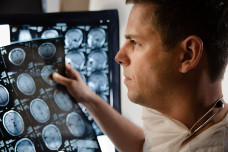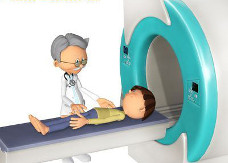Computed Tomography (CT, CAT scan)
Author: Gesche Tallen, MD, PhD, erstellt 2003/12/11, Editor: Maria Yiallouros, Reviewer: Prof. Dr. med. Ursula Creutzig, English Translation: Hannah McRae, Last modification: 2015/05/08
Computed tomography (CT or CAT scan) uses x-rays and a computer to create images, in which parts of the body can be seen in layers. In children and adolescents with cancer, this imaging technique is often performed for obtaining a primary diagnosis, for staging and for the planning of surgery and radiation therapy, usually in addition to magnetic resonance (MRI) imaging. Because CAT scans can be done fast and are readily available, they also serve regularly for diagnostics in emergencies.
During the procedure, the patient lies down and should not move. A computer-controlled x-ray machine will then take and process thousands of cross-sectional x-ray images of specific areas of the body on centimeter or millimeter intervals, sometimes even in 3D (3D-CT). The doctors look at them on the screen or printouts.
As typically seen in standard x-ray images, bones and other dense structures appear white, while soft tissue (like the heart) present in shades of grey, and air-filled structures (like the lungs and intestines) look black in a CAT scan. Because of the modern technology used nowadays, even infants and young children can undergo CAT scans without the need of sedation or general anesthesia.
Sometimes during or after a cancer treatment, the doctors must differentiate between vital tumour tissue, which represents remaining or recurrent cancer, and scar tissue as a result of surgery and/or radiotherapy. For this differentiation, they have to give a contrast medium into the patient's vein that will distribute in vital, but not in scar tissue. The application of contrast medium may be required for other diagnostic questions as well.
Children and adolescents with cancer usually have a central venous catheter (such as the Broviac catheter), which will be used to administer the contrast medium pain-free.
A CAT scan does not hurt. However, it is associated with exposure to radiation. The evaluation of a CAT scan is always performed with a radiologist. Except in the case of a life-threatening emergency, a child under the age of 18 may only undergo a CAT scan if the parent or legal guardian has signed informed consent and been informed and debriefed by a radiologist.


